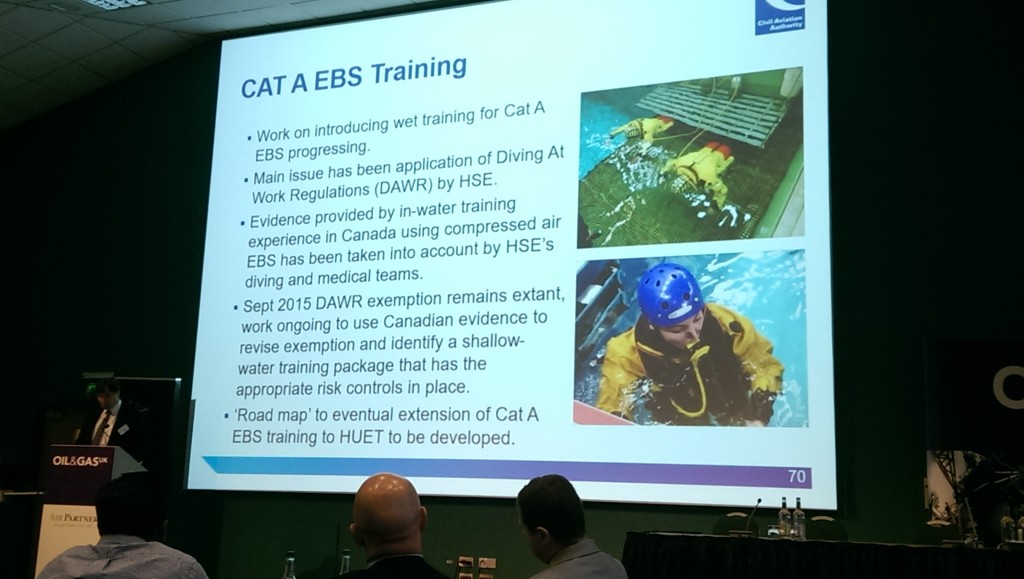OPITO Compressed Air Emergency Breathing System (CA-EBS) Initial Deployment Training Standard
OPITO has issued a standard for Compressed Air Emergency Breathing System (CA-EBS) Initial Deployment Training, to support the initial introduction of Category A Emergency Breathing System (EBS) following the a UK Civil Aviation Authority (CAA) Review, which resulted in the CAP1145 report.
To successfully complete this 1.5 hour ‘dry’ training, delegates must able to:
- Explain the fundamental differences between re-breather and compressed air systems (technology and use)
- Explain the rationale and use of CA-EBS in helicopter emergencies
- Explain the hazards associated with CA-EBS
- Demonstrate a pre-flight inspection of the life jacket and CA-EBS
- Demonstrate donning the life jacket with CA-EBS correctly, including ‘buddy check’
- Demonstrate an emergency deployment of the CA-EBS in a dry environment
UPDATE 1 July 2014 Step Change in Safety issued a further update:
The approval and certification of the new CAT A EBS and the MK 50 Lifejacket is progressing and expected within the next few days. This is a credit to the great work that the HSSG EBS Workgroup has done in collaboration with Survitec Group. OPITO have pulled out all the stops and developed and issued the training standard in record time. Their approach has been one of pragmatic support and as a result has offered considerable flexibility in how we, as an industry, can meet the challenge of training everyone to use the new EBS equipment. In the next few days we will issue support material to member companies to provide them the necessary information as we move into the next critical phase of training and deployment.
The new dual chamber Mk 50 lifejacket, from UK company Survitec, is to be approved by the European Aviation Safety Agency (EASA) and the EBS is to be approved by CAA in accordance with the Category A specification in CAP1034.
Aerossurance has discussed the Category A EBS previously here and the recent Oil & Gas UK’s annual aviation seminar here.
UPDATE July 2014 Step Change in Safety issued a further update that detailed the system’s performance and further roll-out plans.
UPDATE 1 September 2014 Energy Voice interviews Step Change in Safety team leader Les Linklater.
UPDATE 1 November 2014 OPITO has commenced their periodic review of the 3 day Basic Offshore Safety Induction and Emergency Training (BOSIET) and the 1 day Further Offshore Emergency Training (FOET) courses. Its within these that most HUET training is delivered. Among the issues being considered are:
- These are international standard but the CA-EBS is mandatory in the UK only, how to keep the standard generic worldwide?
- In-water CA-EBS training has potential health risks, how to prevent accidents from happening during training?
- In-water CA-EBS training might conflict with local laws and regulations, how to make sure that the training stays within local legislation?
UPDATE 14 December 2014: Further CA-EBS options have now been approved.
UPDATE 24 December 2015: UK BOSIET/FOET Cat-A EBS HUET Update
UPDATE 24 January 2016: CAP1145 Helicopter Water Impact Survivability Statistics – A Critique
UPDATE 25 January 2016: OPITO has issued an update that the ‘interim’ standard will be introduced across the UK on 15 February 2016. They have provided two sets of FAQs:
UPDATE 20 September 2016: The UK CAA today briefed the Oil and Gas UK Aviation Seminar the following:
UPDATE 26 September 2017: ASD-STAN prEN 4856 for Rotorcraft — Emergency Breathing Systems (EBS) — Requirements, testing and marking has been issued. This will then become a full European Standard (EN) via CEN and be incorporated in an EASA ETSO.
Aberdeen based aviation consultancy Aerossurance has a proven track record in helicopter safety, air logistics, airworthiness, survivability and accident analysis. For aviation expertise you can trust, contact us at: enquiries@aerossurance.com
Follow us on LinkedIn and on Twitter @Aerossurance for our latest updates.



Recent Comments